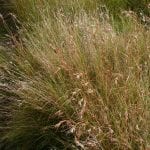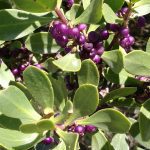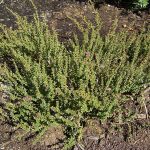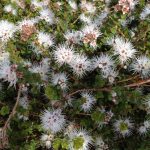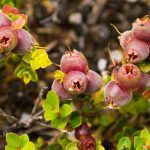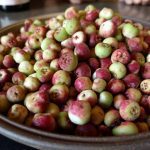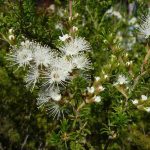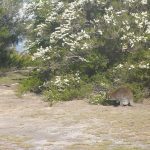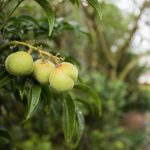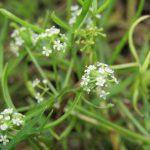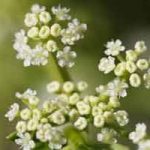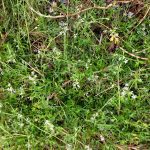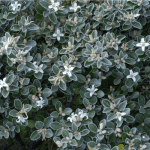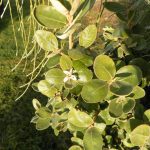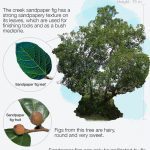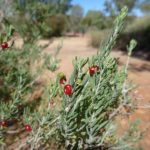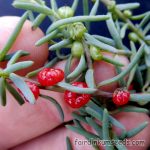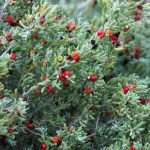
Best Edible Australian Native Plants for the School Garden (Part 2)
Pictured above: Appleberry (featured in Part 1)
This is Part 2 of Linda Dipper from Oz Tukka’s list of recommended edible native Australian plants to grow in any school garden.

Native plants typically grow well in the garden, having evolved specifically to the region’s climate and soil conditions. They are low-maintenance, requiring little to no water apart from rainfall as well as little to no fertilizing. They provide habitat, food and shelter for native bees, birds, insects, small mammals, reptiles and frogs (Source: Government of South Australia).
Specifically edible native plants have been cherished for centuries by native peoples as sources of food and medicine, making them a gateway to learn about indigenous peoples and regional history.
Remember, when choosing native plants for the school garden, choose those that are safe for children, where no parts can incur physical harm (i.e. thorns) and no parts are poisonous or irritating to skin, eyes, etc.
Our list contains only edible, nontoxic plants, safe to grow with children and for up close encounters.

13. Kangaroo Wheat Grass (Themeda triandra):
This drought tolerant, easy-going grass is found in all states and territories. It’s a historically rich plant – the grains are believed to have been used by Indigenous Australians for over 30,000 years in bread making (Bruce Pascoe’s best-selling novel Dark Emu reports usage of the grass going back 65,000 years ago). Indigenous peoples also used the leaves and stems for cords and string, like fishing nets – similar to the Blue Flax Lily #6 in Part 1. Colonial Australians found this grass desirable for cattle feed. The grey-green leaves turn orange-reddish-brown in the summer and it is known to attract butterflies, birds and lizards.
- Aboriginal name: Not found
- Edible parts: Seed
- Culinary use: Grind the dried grains for porridge and flour. The flour has a unique, nutty flavour for breads and damper. The seeds, when picked just after ripening, taste like “fresh green peas.”
- Medicinal use: Not much is reported for human health, but in Australia people use kangaroo grass as a health food for grazing or stabled horses to remediate obesity, insulin resistance and foot inflammation – due to its lower carbohydrate content than introduced grasses.
- Sources: Australian Government Native Plants Initiative, Planting Seeds
14. Boobialla / Native Juniper (Myoporum insulare)
This hardy, salt-tolerant shrub with deep purple fruits grows wild on the coast, sand dunes, cliff sides and mangrove fringes. It likes full sun and easily draining soil. Boobialla attracts birds, bees, insects and lizards – grow it to support native wildlife and love it for the fruits!
- Aboriginal name: Bubiala (Tasmanian language)
- Edible parts: fruits, Note: unlicensed, foraged picking of the fruit is illegal and other members of the Myoporum genus contain known toxins and can be harmful in large quantities – all the more reason to choose the right genus and grow it yourself!
- Culinary use: Use the fully ripe aromatic, juniper-like fruits in jams, jellies, essential oils and cocktails. The fruits’ astringent sweetness make them well suited to preparations with sweeteners as opposed to fresh eating.
- Medicinal use: None noted.
- Source: Edible Oz, Tucker Bush
15. Kunzea / Tick Bush (Kunzea ambigua) / Muntries / Emu Apple / Muntaberry / Monterry (Kunzea pomifera):
Related to bottlebrushes and tea trees – kunzea ambigua is a medium to large woody shrub found in heath/shrubland and open forests in southern New South Wales, eastern Victora and Tasmania. Native wildlife and small animals take shelter under this plant which has been researched and proven to treat insect bites and infestations (especially ticks and mites), hence its common name ‘tick bush.’ Kunzea pomfiera grows similarly, but on a smaller scale and is used less for its medicinal properties and more for its tasty berries – called ‘Australian cranberries’ or ’emu apples’.
- Aboriginal name: Ngurp (Bunganditi, VIC & SA), kitja, boorn, poorndil or condil (Noongar peoples)
- Edible parts: Leaves, flowers, berries
- Culinary use: The dried or fresh leaves can be used to season roasts and vegetables. Great to add to soups as well as in baking, particularly for bread recipes. The purple/red fruits have a crunchy texture and spicy apple flavour – delicious raw, in salads or cooked in jams, pies, muffins, or roasts.
- Medicinal use: The berries contain 4x the antioxidant power of blueberries. Use the plant or plant oils to treat insect bites, infections and infestations. The oil contains both strong antiviral and anti-inflammatory constituents – used for arthritis, joint pain, skin irritations, headaches, respiratory issues, skincare, stress relief, anxiety, fungal and bacterial infections and more. Read more on the use of Kunzea oil.
- Sources: Australian Native Plants Society, Zea, Bush Sense, Tucker Bush
16. Small Leaf Tamarind (Diplogottis campbellii):
Small leaf tamarind is a small, shade loving tree with dense foliage, found in the rainforest areas of New South Wales and Queensland. Less than 2 years ago, there were only 150 of these trees in the wild, making it an endangered species that we should plant not only to encourage the continuation, but also for its abundant, deliciously tangy fruits! The funky fruits start from yellow-brown bulbs that are ready to harvest once they split open to show the bright red fruits which can grow up to 6cm in diameter!
- Aboriginal name: Not found
- Edible parts: Fruit
- Culinary use: The fruits taste tangy and tart. If you’re able to save any for later, they make great jams, jellies, sauces, fruit chutneys, spreads and coulis.
- Medicinal use: The small leaved tamarind fruit has a high content of vitamin C, which boosts the reaction of the human immune system and prevents cold, flu and other infections.
- Sources: NSW Office of Environment & Heritage, Elma Skincare
17. Sea celery (Apium annuum):
Thriving on the coast, sandy beaches and salt marshes, sea celery was a survival food for first Europeans newly arriving in Australia who correctly recognised that this plant is related to European celery and parsley, and is therefore safe to consume. Aboriginal peoples also used the plant, but didn’t depend on it as desperately for nutrition as they had the knowledge of many edible bush plants.
- Aboriginal name: Not known
- Edible parts: Leaves and flowers
- Culinary use: Use fresh, as you would parsley or celery, in soups, salads, quiches, curries, tacos, anything!
- Medicinal use: Its high vitamin C content helped the early European settlers stave off scurvy
- Source: Tucker Bush, Sustainable Gardening Australia
18. Sea Parsley (Apium prostratum var. prostratum):
With much in common with #17 Sea Celery above, sea parley was also a coastal growing familiar food friend to the early European colonists. Its rich vitamin C content was reported as used by Captain Cook to stave off survy. Sea parsley tastes much like European parsley, with an oceanic salty flavour. Grow this hardy plant with your preschoolers and watch it withstand trampling, tugging and eager hands with grace.
- Aboriginal name: Not known
- Edible parts: Leaves and flowers
- Culinary use: Use fresh, as you would parsley or celery, in soups, salads, quiches, curries, tacos, anything!
- Medicinal use: Its high vitamin C content helped the early European settlers stave off scurvy
- Sources: Tucker Bush, Sustainable Gardening Australia
19. White Correa / Cape Barren Tea (Correa alba):
This tough little plant can not only handle dry soil and harsh winds, but it is also easily pruned to a shape, so pick something fun with your students and manicure this little guy with little scissors into the shape of Australia! The plant has furry undersides to its leaves and small star-shaped white flowers – both the leaves and flowers can be steeped in a flavourful, sweet tea.
- Aboriginal name: Not found
- Edible parts: Leaves, flowers
- Culinary use: Use the aromatic sweet leaves in tea and to flavour foods like cake icing. Eat the flowers fresh or use as a garnish.
- Medicinal use: None noted
- Source: Gardening with Angus, Australian Native Plants Society, Mystastrious Native Edible Plants
20. Sandpaper Fig (Ficus coronata):
Rough leaves give this fig its name, but don’t let that keep you from harvesting the fruits, which some decree as the best tasting fig in Australia! First Nation Peoples used this multidimensional plant in multiple ways – the leaves to polish weapons, the bark to make string and the fruit to enjoy. It thrives in eastern Queensland and New South Wales.
- Aboriginal names: Not found
- Edible parts: Fruit
- Culinary use: Remove the furry skin before eating or using. Eat fresh and use fresh or dried in cakes, pies, biscuits, jams and sauces.
- Medicinal use: Historically used to fight ringworm infections, rubbing the skin raw with the leaves and then applying the milky sap that oozes from damaged leaves.
- Source: Tucker Bush, The Conversation
21. Old Man Saltbush (Atriplex nummularia):
Growing all over Australia, especially as a common livestock grazing plant, this salty, silvery shrub has seeds and leaves that you can eat – if you can handle the saltiness! Our Preschool Cook at Sustainable Play is known to used it in the kitchen in her famous damper recipe.
- Aboriginal name: Tjilyi-tjilyi
- Edible parts: Leaves and seeds
- Culinary use: Use the leaves like a leafy vegetable – blanched, sautéed, in salads, curries, stuffing and breads. Use fresh or dried.
- Medicinal use: Leaves contain protein, antioxidants and minerals and are high in Vitamin C
- Sources: Tucker Bush, Growing Native Plants: An Australian Government Initiative
22. Ruby Saltbush (Enchylaena tomentosa):
Like #22 Old Man Saltbush, Ruby Saltbush also grows all over Australia and gets its name from its salty taste and ability to grow in saline soils. However, in addition to salty leaves and seeds, this saltbush produces salty ruby red berries! Enjoy the comparing and contrasting that can be observed among these two different saltbushes with the preschoolers.
- Aboriginal name: Not found
- Edible parts: Berries and leaves
- Culinary use: Eat any raw berries and leaves sparingly due to the high oxalate content. Soak the fresh berries in water for sweet tea. Cook the leaves and berries in creative dishes to reduce the oxalate content. Leaves can be used as a seasoning to flavour stir-fries, in marinades, soups and sauces.
- Medicinal use: High in vitamin C
- Sources: Tucker Bush, Growing Native Plants: An Australian Government Initiative
Thanks to Linda Dipper, owner of Oz Tukka in Redhead who gave us her list of best native edible plants to grow in the school garden!
Written By
Suzie has always loved working with children and graduated from Boston College’s School of Education with a Bachelor’s in Human Development/Applied Psychology and Communication.
Since having her first child and moving to Australia with her husband, Suzie has been excited to be working with Sustainable Play Preschool where her values in sustainability, education and care for the natural world all come together beautifully.



